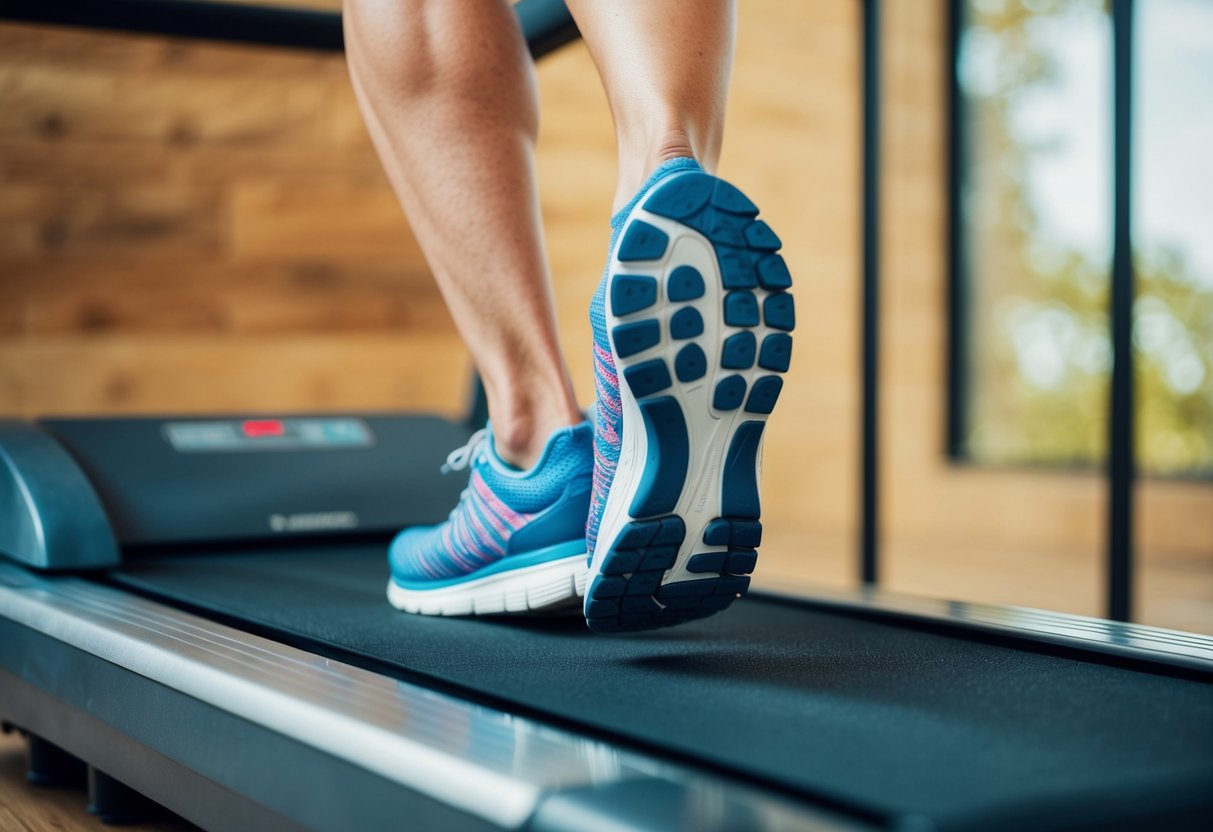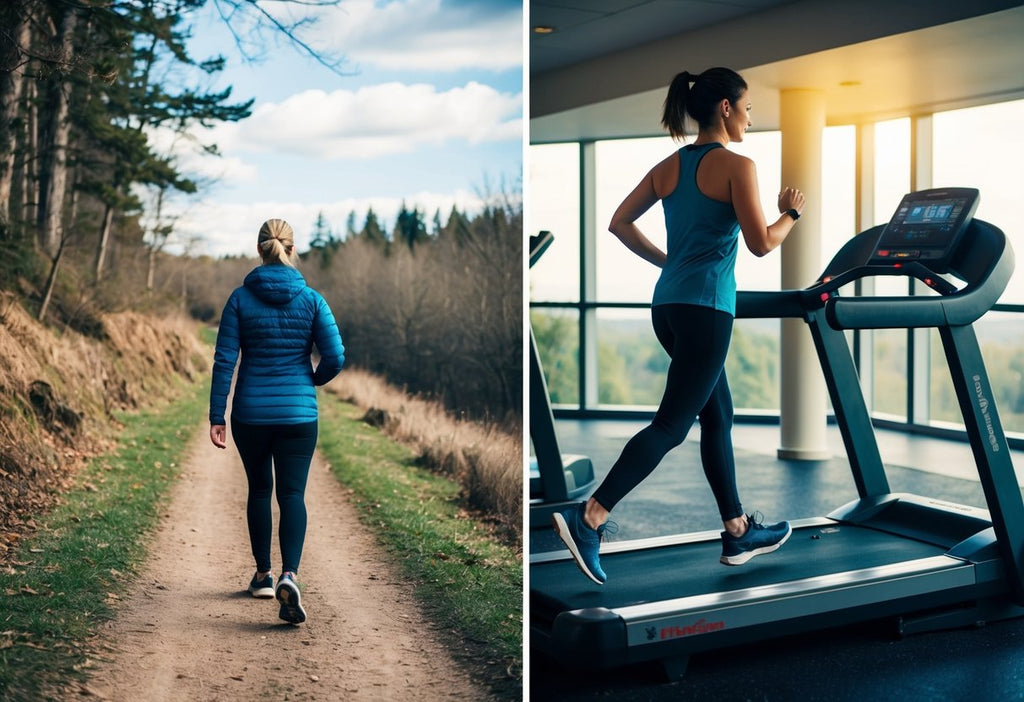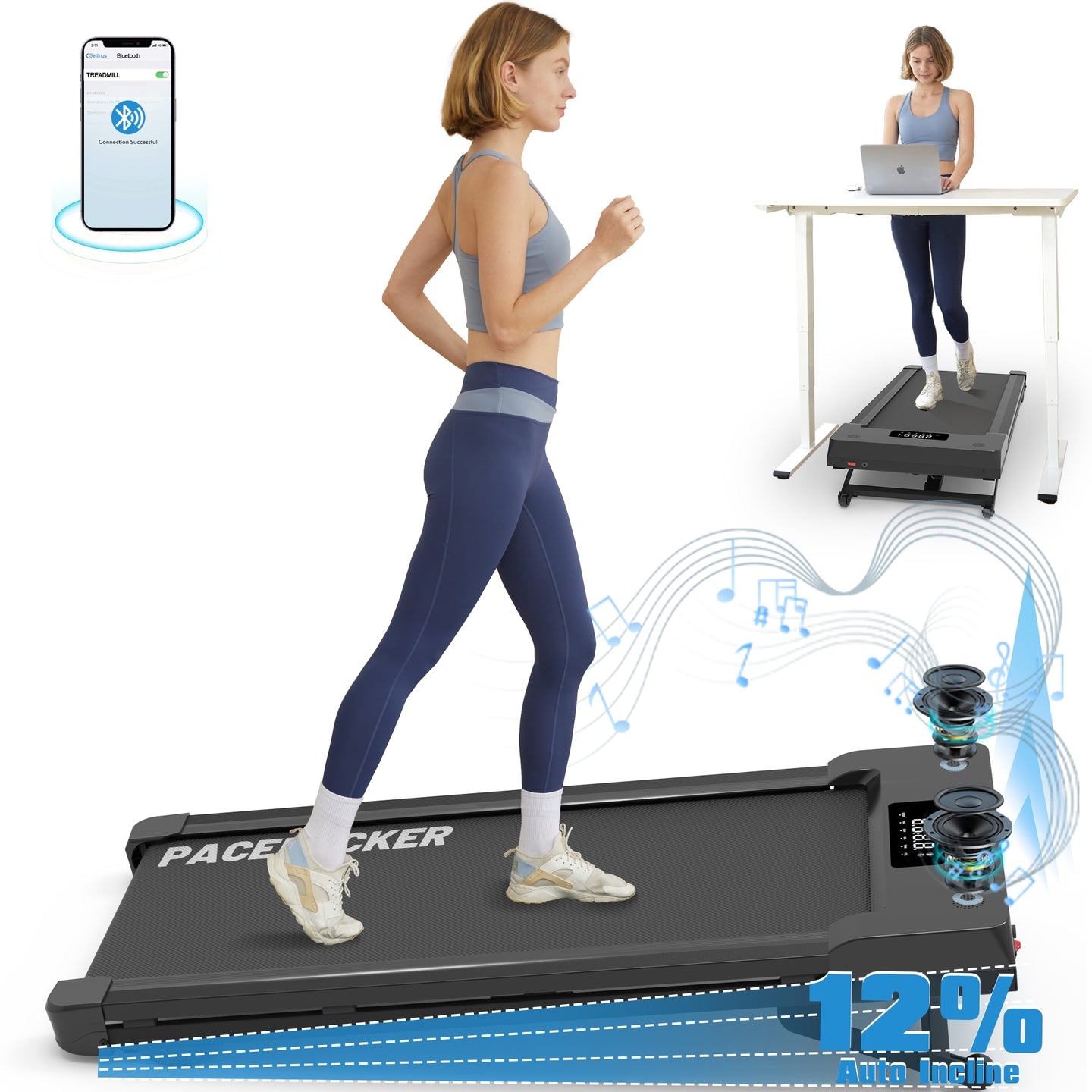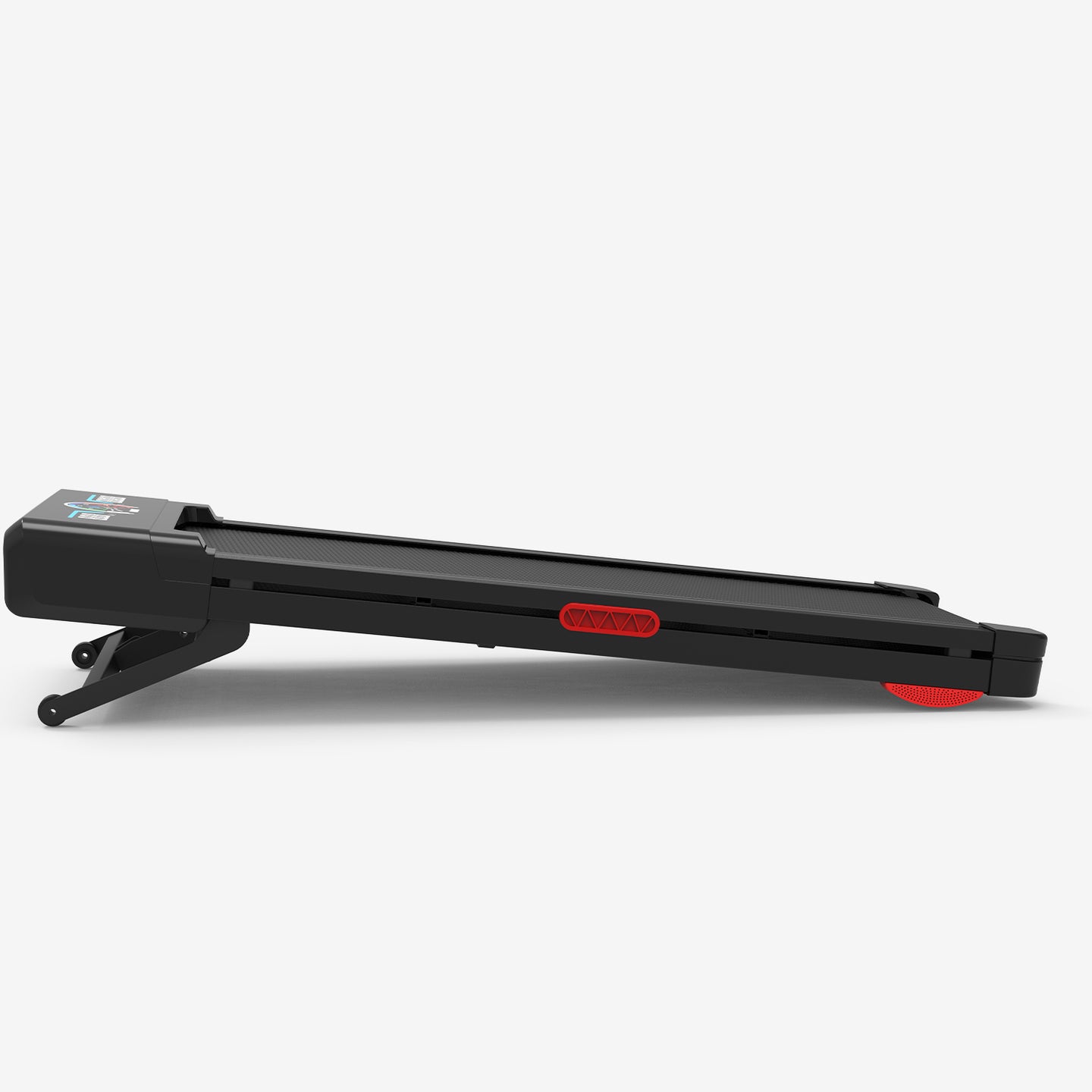Running Barefoot on Treadmill

Don’t forget to check out our Pacerocker, Trailviber, and Trailviber Auto Incline walking pad treadmills.
Running has always been a favorite activity for many people seeking a healthy lifestyle. With the rise of barefoot running, this trend is now making its way onto treadmills. Running barefoot on a treadmill can provide a unique way to connect with our bodies and improve our form. Many of us wonder if it's a viable option for regular workouts.
We often find that running barefoot feels more natural and can help strengthen foot muscles. This method encourages better posture and can reduce the impact on our joints. While it sounds intriguing, it's important to think about safety and readiness before starting. Can running barefoot really offer more benefits than using minimalist shoes or regular running shoes?
We’ve explored the pros and cons to make sure that safety is a top priority. There are several factors to consider when we decide to try this. We'll look at tips for starting out safely and ways to avoid injuries. Dive into these insights with us to enhance your treadmill running experience.
Key Takeaways
- Running barefoot on a treadmill can improve form and posture.
- There are potential risks that need attention to ensure safety.
- Start slowly and follow best practices to prevent injury.
Benefits of Running Barefoot on a Treadmill
Running barefoot on a treadmill can improve our awareness of body movement, help us adopt a more natural running style, and strengthen specific muscles. These aspects lead to a more balanced and efficient way to run, boosting both performance and enjoyment.
Enhanced Proprioception and Balance
When we run barefoot, we become more aware of how our feet hit the treadmill. This awareness is known as proprioception. It tells us where our body parts are in space. Running sans shoes enhances this, improving our coordination and balance.
By feeling direct contact with the surface, our feet can adjust instantly. This improves our ability to make quick and balanced movements. Better balance reduces the risk of injury and enhances confidence. It makes running smoother and more enjoyable. Over time, we can develop stronger neural connections, engaging our muscles more effectively.
Natural Gait and Reduced Overstriding
Running without shoes encourages a natural gait, allowing us to land on our midfoot or forefoot instead of our heels. This change reduces the impact forces that travel through our legs. Overstriding, or landing with your foot too far ahead, is reduced, leading to a more efficient stride.
This natural style helps in minimizing unnecessary energy expenditure. As our step becomes more compact, we avoid putting stress on our joints. Reduced shock means fewer long-term injuries. When our stride aligns with natural movement patterns, running feels more fluid and less forceful, enhancing our overall performance.
Strengthens Calf Muscles and Achilles Tendon
Barefoot running challenges our calf muscles and Achilles tendon. These areas take on more of the workload, especially if we're not used to this style. The muscles and tendon strengthen over time as they adapt to this new way of moving.
Stronger calves support our legs, improving our push-off with each step. The Achilles tendon becomes more resilient, reducing the risk of strains. This results in increased lower leg power and endurance, aiding in longer runs or quicker sprints. Building up these muscles and tendons contributes to a robust foundation for running.
Comparing Barefoot Running to Minimalist Shoes
When considering barefoot running and minimalist shoes, we must think about how they affect our running form and the benefits they offer. Both have unique advantages that appeal to different runners.
Advantages of Minimalist Running
Minimalist shoes are designed to mimic the experience of barefoot running while providing some protection. They have a thin sole and a wide toe box, allowing our feet to move naturally. This can help in strengthening foot muscles over time.
Protection is a key benefit. These shoes shield us from sharp objects and rough surfaces. They also offer a small amount of cushioning, which can ease the transition for those new to barefoot-like running. This way, we can enjoy the freedom of movement without worrying about injuries from debris.
Another advantage lies in versatility. Minimalist shoes can be used on varied terrain, from pavements to trails. This allows us to switch up running environments without needing different footwear. These factors make minimalist running appealing, especially for those who want a balance between natural feel and protection.
Key Differences in Running Form
Our running form can change significantly when choosing between barefoot running and minimalist shoes. When running barefoot, we tend to adopt a forefoot or midfoot strike, which reduces impact on the heels. This can potentially decrease the risk of heel-related injuries.
Minimalist shoes encourage a similar forefoot strike. Though they offer some protection, we still notice a more natural gait compared to traditional running shoes. The presence of a thin sole, however, may alter our sensitivity to the ground slightly. This can influence the way we adjust our strike compared to running completely barefoot.
Another difference is in the arch support. Barefoot running provides no support, allowing our arches to take more of the load naturally. In contrast, some minimalist shoes offer minimal support, which can assist in maintaining proper form, especially during longer runs. These distinctions are crucial for us to consider when choosing the best option for our running routine.
Potential Risks of Barefoot Treadmill Running
Running barefoot on a treadmill can feel natural, but it comes with certain risks. We need to consider injuries due to overuse, the chance of blisters or friction burns, and the possibility of stress fractures or plantar fasciitis.
Understanding the Risks of Overuse Injuries
Wearing no shoes might lead us to adjust our natural stride differently on a treadmill. This adjustment often results in increased stress on our feet and legs. Overuse injuries like tendonitis and shin splints are common because we're relying more on muscles and tendons for shock absorption.
It’s crucial we listen to our bodies and start slowly. Gradually increasing time and intensity on the treadmill helps minimize these risks. It’s also helpful to alternate between barefoot and shod running to give our muscles time to adapt and recover.
Strengthening exercises for the feet and legs are essential. Incorporating them into our routine can prevent injuries associated with overuse. Keeping a keen eye on our form can ensure that we’re not placing unnecessary strain on any part of our body.
Preventing Blisters and Friction Burns
The treadmill surface can cause friction on our feet, leading to uncomfortable blisters. The repetitive motion of running barefoot increases this friction, making our feet more susceptible. We need to ensure that the tread is clean and smooth to prevent this.
Some find it helpful to use foot lubricants or protective gels. These can decrease friction and protect our skin. Regularly moisturizing our feet can also prevent dryness, which makes our skin less likely to crack and blister.
Starting with shorter, less intense runs can give our skin a chance to toughen up gradually. Monitoring for signs of redness or soreness can help us address issues early before they become severe.
Avoiding Stress Fractures and Plantar Fasciitis
Stress fractures are small cracks in the bones caused by repetitive force. Barefoot running can increase the risk due to the lack of cushioning that shoes provide. We can prevent these injuries by slowly increasing our running duration and intensity.
Plantar fasciitis involves pain in the bottom of the foot. Barefoot treadmill running can strain the plantar fascia. Stretching exercises focusing on the foot and calf muscles can help keep this ligament flexible.
Listening to our bodies by stopping at any sign of discomfort is crucial. Adequate rest between runs can prevent overloading our feet and maintain overall foot health.
Best Practices for Barefoot Treadmill Running
When running barefoot on a treadmill, it’s crucial to start with short sessions, focus on maintaining a proper running gait, and adapt to the unique surface of the treadmill. These practices help minimize injury risks and enhance comfort.
Starting with Short Sessions
We should begin our barefoot treadmill journey with short, controlled sessions. Running unshod can put muscles under strain since they may not be used to being barefoot. Starting with 5-10 minutes allows our bodies to adjust gradually. Listening to our body is key. If there's discomfort, pausing is a good idea. Gradually increasing the time by a few minutes each session can help in building endurance and strength safely.
We must also pay attention to any soreness post-session as it might indicate the need for more rest before the next run. Building up slowly is essential for a safe transition to longer distances. Being patient ensures our feet and calves get accustomed to the new sensation without overexerting muscles.
Focusing on Proper Running Gait
Maintaining a proper running gait is vital for barefoot treadmill running. We should aim for a midfoot or forefoot strike to reduce impact on the joints. This style helps in utilizing the foot's natural shock absorbers. Keeping our posture upright with a slight forward lean can help improve balance. Shortening our stride can also minimize stress on the lower legs.
Concentration on a soft landing reduces impact forces. Our knees should stay slightly bent to absorb shocks better, helping prevent injuries. Maintaining a consistent tempo, like a metronome, can make our running smoother and more efficient. Proper gait is the foundation of safe, effective barefoot running.
Adapting to the Treadmill Surface
To successfully adapt to the treadmill’s surface while barefoot, we need to become familiar with its unique texture. Most treadmill surfaces are non-uniform, which can provide both benefits and challenges. Warming up the equipment first ensures we’re ready for the differences compared to outdoor running.
Being mindful of our foot placement is crucial for maintaining rhythm. The belt’s motion can affect how we adjust our steps. We should experiment with different speeds to learn what's comfortable and sustainable. Awareness of the treadmill's surface, combined with controlled footwork, is crucial in gaining confidence and maximizing the benefits of barefoot treadmill running.
Injury Prevention and Recovery Strategies
Running barefoot on a treadmill can be quite different from regular running. We need to take extra care to prevent injuries, such as shin splints and muscle soreness, and pay attention to recovery. Let's look at some strategies that can help.
Warm-Up and Cool-Down Routines
Starting our run with a good warm-up is key. We can try gentle leg swings, ankle circles, and light jogging for about 5-10 minutes. This helps get our blood flowing and primes our muscles.
Cooling down after running is just as important. Stretching exercises, like toe touches and calf stretches, help relax our muscles. Spending just 5 minutes on this helps reduce stiffness and speed up recovery.
Techniques to Avoid Shin Splints and Muscle Soreness
Shin splints can be a common issue when starting or increasing our treadmill running. To avoid them, we can focus on building a strong lower body. Exercises like calf raises and toe taps strengthen our muscles and improve flexibility.
Let's not forget our posture and foot strike. Keeping our back straight and landing softly on the middle of our foot reduces stress on our legs. Gradually increasing distance and speed prevents muscle soreness and injuries, too.
Addressing Overuse Injury Concerns
Running barefoot might lead to overuse injuries if we're not careful. It's important to listen to our bodies and not push ourselves too hard. We can keep a journal to track our runs and note any pain or soreness.
Cross-training with activities like swimming or cycling can give our legs a break and build strength. It's helpful to mix running with rest days to allow our muscles to recover and adapt.
Incorporating these strategies can make barefoot treadmill running a healthier and more enjoyable experience for all of us.
Advanced Techniques and Workouts
Running barefoot on a treadmill can enhance our stability and stride, introduce effective interval training, and offer varied workouts through inclines and speed changes. These techniques help strengthen muscles and improve running efficiency.
Increasing Stability and Stride Length
When running barefoot, stability becomes crucial. We must focus on landing gently and maintaining balance. Core exercises, like planks or bridges, strengthen our center, helping stabilize each step.
Stride length improves with awareness of our foot placement. Shorter, more frequent strides can lower impact forces. Practice running drills, such as high knees and butt kicks, to boost both stability and stride efficiency. Consistent practice increases comfort and control on the treadmill.
Utilizing Interval Training
Interval training enhances cardiovascular fitness by alternating between high and low intensities. On a treadmill, try doing one-minute sprints followed by walking or jogging for two minutes. This variation challenges us and prevents monotony.
Barefoot running requires extra attention to our form. Monitor how our feet strike the treadmill and adjust as needed. Incorporating intervals helps focus on developing speed and endurance without compromising form. Keep sessions short and intense for best results.
Incorporating Inclines and Speed Variation
Inclines simulate hill running, introducing new challenges. They force different muscle groups to engage and help improve our overall strength. Start with a slight incline and gradually increase as we become more comfortable.
Changing speeds keeps our workouts dynamic. Include short bursts of fast running, followed by recovery periods. This challenge improves agility and mimics varied terrain, offering a comprehensive workout. Adjusting incline and speed encourages our body to adapt, increasing endurance and power.
By combining these techniques, we elevate our barefoot treadmill running experience, promoting healthier and more efficient exercise habits.
Community Insights and Experiences
As we explore barefoot running on treadmills, two main areas offer valuable perspectives. Online platforms provide diverse viewpoints, while personal stories highlight experiences in transitioning from traditional to barefoot running.
Leveraging Online Platforms like Reddit
We often turn to Reddit for firsthand accounts and advice. It's a hub of runners sharing their stories and tips about barefoot running on treadmills. Users discuss benefits like improved foot strength and natural running technique. Some share challenges, like initial discomfort or adjusting to the new style.
Threads often feature debates about safety. Some users emphasize starting slow, while others recommend specific treadmill settings for comfort. The community supports by offering insights into choosing the right treadmills, suggesting ones with softer belts for beginners. Information is often accompanied by lists of suggested practices or product recommendations.
Personal Stories of Transitioning to Barefoot Running
Transitioning to barefoot running can be a unique journey. Some runners tell us about a gradual shift to adapt to this new style. For many, starting indoors on a treadmill feels safe due to a controlled environment. Others mention beginning with short sessions to slowly build endurance and confidence.
We hear about experiences of increased foot flexibility and a closer connection to natural running. Some runners report it helped improve posture and reduced injuries. Stories about overcoming the initial phase of sore muscles are common. They often highlight persistence as key, encouraging fellow runners to stay patient and listen to their bodies during this transition.
Frequently Asked Questions
Running barefoot on a treadmill has its benefits and challenges. It's important to compare it to using barefoot-style shoes and consider how it affects form and health. Let's explore some common questions.
What are the benefits and potential drawbacks of running barefoot on a treadmill?
Running barefoot can improve foot strength and balance. We might experience better sensory feedback, leading to more natural movement. Still, there’s a risk of injury from lack of padding and foot protection.
How does running barefoot on a treadmill compare to running with barefoot-style shoes?
Barefoot-style shoes offer some cushion and protection while allowing flexibility. They might reduce the risk of cuts and blisters on the sole. Running fully barefoot provides more direct contact with the treadmill but may increase injury risk if not done carefully.
Can running on a treadmill without shoes improve my running form or foot health?
Yes, going barefoot can help some runners adopt a better posture and stride. Without shoes, we might use our muscles more efficiently, which can enhance foot strength. It’s crucial to listen to our bodies and avoid overdoing it.
Are there any specific techniques to safely transition to barefoot treadmill running?
Transitioning safely requires gradual adaptation. We recommend starting slow with short sessions to let our feet acclimate to the new demands. Building up gradually can help avoid stress injuries.
What type of surface is best for someone considering barefoot treadmill workouts?
A smooth, cushioned treadmill belt is ideal. We should ensure the treadmill is free of debris and inspect for any worn or abrasive areas. This can prevent cuts and discomfort.
How can walking or running barefoot on a treadmill affect overall exercise experience?
Running or walking barefoot can make us feel more connected to our movements. This might make workouts more enjoyable and mindful. However, adjustments to speed and time may be necessary as we adapt to the barefoot approach.
Discover the benefits of running barefoot on a treadmill, improving form and posture while considering the risks to ensure a safe workout experience.






